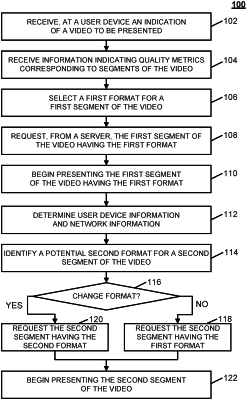| CPC H04L 65/80 (2013.01) [H04L 65/75 (2022.05); H04N 7/01 (2013.01); H04N 21/442 (2013.01); H04L 67/61 (2022.05)] | 21 Claims |

|
1. A method for selecting video formats for adaptive video streaming, the method comprising:
receiving, at a server including a hardware processor, an indication of a first video to be presented on a user device;
generating, at the server, by inputting video features of the first video into a trained model, a group of predicted viewership scores for each format from a group of available formats for the first video;
selecting, at the server, a first format for a first video based on the group of predicted viewership scores for the first video;
causing, at the server, the first video to be presented on the user device;
identifying, at the server, a quality of a network connection between the user device and the server that hosts the first video during the presentation of the first video on the user device;
identifying, at the server, a second format for a second video based on the quality of the network connection;
determining, at the server, whether a format of the second video is to be changed from the first format to the second format based on the group of predicted viewership scores for the second video; and
in response to determining that the format of the second video is to be changed from the first format to the second format, causing, at the server, the second video to be presented by the user device.
|